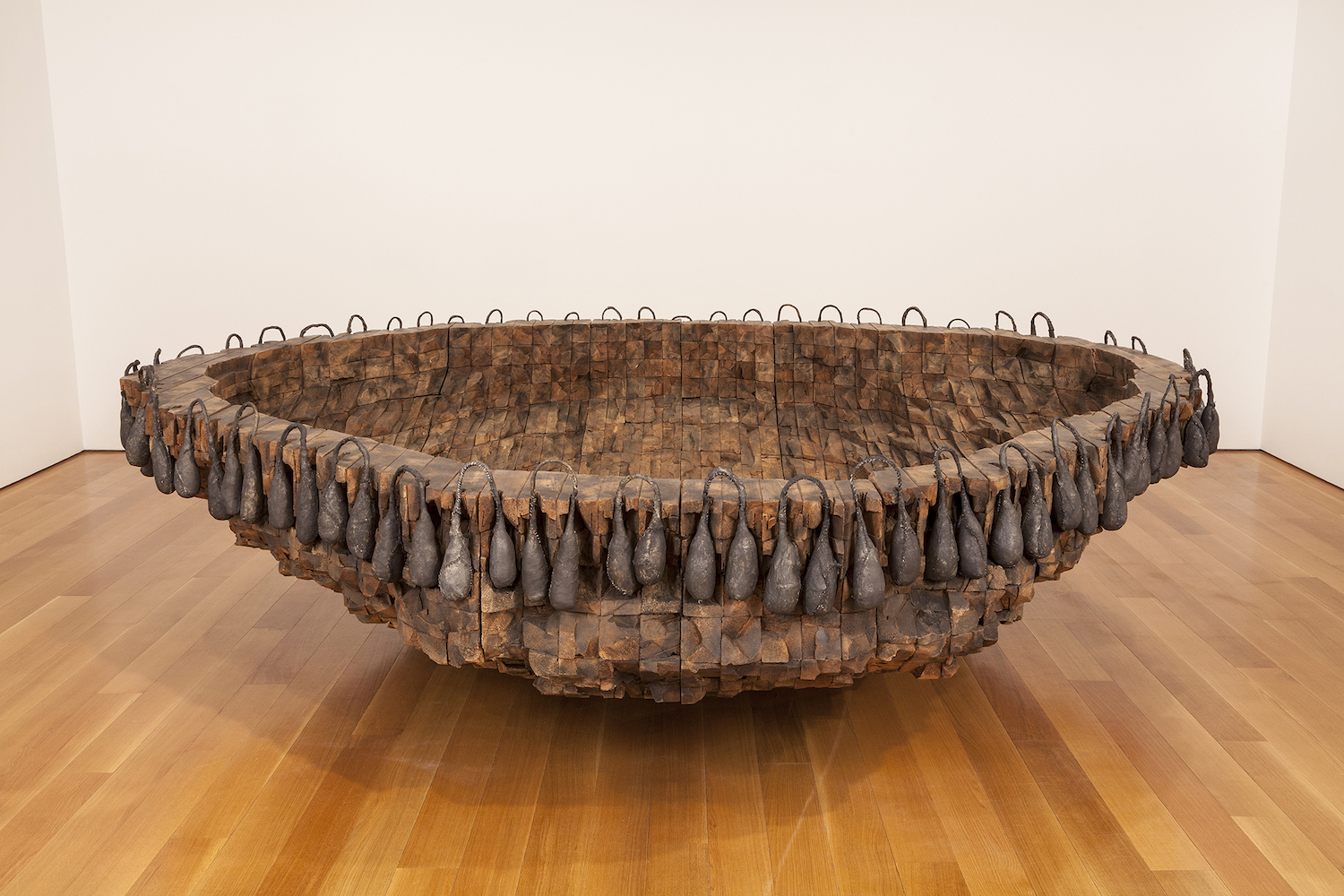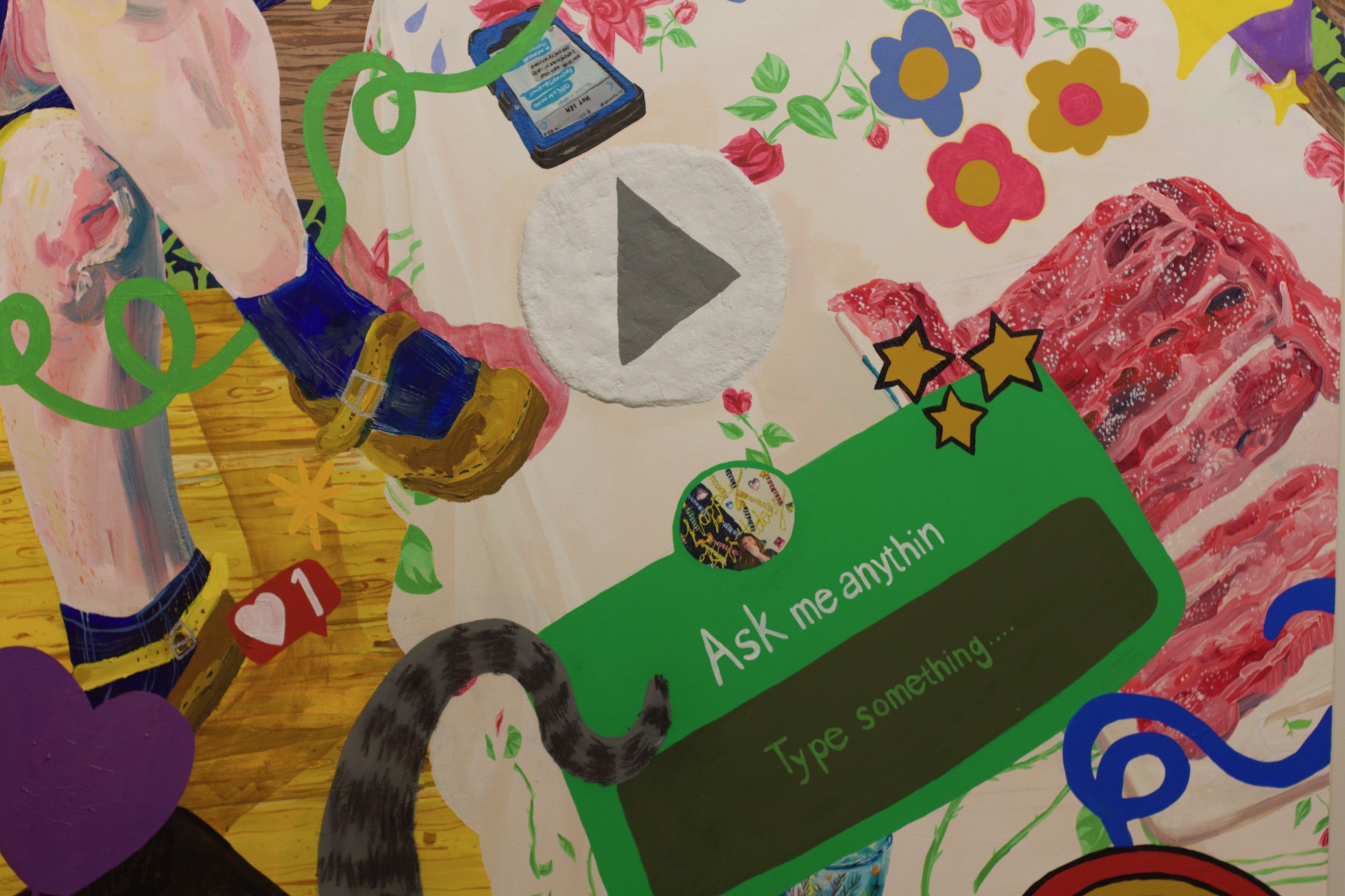Nicole Dyer’s paintings beg to be touched. Bright pinks and greens and yellows burst from textured surfaces, with layers of acrylic paint and papier maché applied like icing. Candy pieces tantalize, strewn about as if a piñata spilled its guts just as a coat started to dry. A delicious landscape beckons you to play.
In many ways, Dyer’s show at Current Space, It’s Okay Maybe, feels like a kid’s birthday party. It’s loud. Confetti covers the floor. It’s a little anxiety-inducing.
In “Pearl’s Room,” books, vitamins, and clothes crowd a bedroom, while green slime threatens from above. “Balenciaga,” a sculpture painted a traffic-sign yellow and made of cardboard and papier maché, is part designer bag, and part monster. Polymer clay peppermint candies overflow from its zippered mouth, ready to chomp. In “Big Phone,” a two-foot-tall hand hovers over the Instagram feed for #carnivorediet. Its index finger lingers over a plate of fried chicken, an image collaged from Bon Appetit magazine, while its thumb rests on an image of a half-opened tin of anchovies below. Blue squiggles dance over top, and actual ginger candies and gems are scattered like sprinkles.

“Balenciaga,” acrylic, papier maché, cardboard, polymer clay, cellophane wrappers (2019); (Background) “Topo Chico,” acrylic, papier maché, ink, cardboard, dowel (2019)
The subject matter of her paintings is often simple—a stack of books, a bonfire, a meal amongst friends—but it overwhelms. Frequent depictions of food and phones provide a steady diet of overindulgence, whether in the form of an ever-scrolling social media feed or just too many sweets.
Dyer was inspired and enticed by colorful candy shops when she traveled to Berlin, Copenhagen, Amsterdam, Venice, and London last year, where confections sparkled behind colorful glass displays. “I was just walking by with my mouth open, like oh my god. But [I was] really afraid to try the things,” Dyer says. “It really affected me that I wouldn’t let myself do that.”
Going abroad was when Dyer started to acknowledge her experience with disordered eating. She tried her first diet at the age of 11, and says that she sometimes still has anxiety eating around people or in unfamiliar places. The bright colors and playfulness of her paintings belie the deeper themes. “I’m actually talking about something that’s really hard for me, but then I’m going to give it to you with glitter on top.” She likens it to making a dark joke. “Some people get it and some people don’t,” she says.
The painting “Pearl’s Room” was inspired by a 9-year-old child that Dyer babysat for a week while in Berlin. One morning, when making pancakes together, Pearl said that she wished Dyer would eat them with her. “I had to think about how I was separating myself from the situation because I wasn’t allowing myself to contribute in that way,” Dyer says. The painting is almost dizzying in its busy contents. Certain features, like the dresser, appear flat and warped, while others, like the phone charger and green goo, literally pop from the painting.
After Europe, Dyer spent three months at the Wassaic residency in upstate New York, where she made work the previous year as well. While there, she recreated the gummy bears and bonbons and pastries she saw in her travels, using hot glue, clay, and insulation foam. After seeing her studio, which Dyer characterized as “an abundance of confectionary,” another resident asked her how she could handle being around so much candy. “They didn’t realize it was fake,” she says. “You can’t actually eat any of it.”

“Rødder & Vin (Copenhagen),” acrylic, flashe, papier maché, polymer clay on canvas (2019)
Art always has an element of “look but don’t touch” but while most galleries are only concerned with protecting work from oily fingers, Dyer’s paintings deal explicitly with restraint and indulgence. You can’t taste the peppermints of “Balenciaga” just as you can’t eat the gummy eggs in “Pearl’s Room.” It feels like standing in front of a display case, a glass pane between you and the objects of your desire.
It’s also a similar feeling to scrolling through Instagram, where envy mixes with unattainability. Social media and snacks each breed a certain type of hunger, and Dyer touches on these parallels in her work. In “Kale’s New Shoes,” an iPhone and a slab of grilled meat rest atop a colorful tablecloth. A person sits at the table, with only their legs in view, and a play button is painted over top with a text bubble that reads “Ask me anythin,” as if this was a still from an Instagram video. But of course you can’t press play.
Dyer says that Instagram has been a useful tool for connecting with friends and sharing thoughts about disordered eating, but she has a love/hate relationship with the app. “It’s an overconsumption, just like with food. I think they go hand-in-hand for me,” she says. They’re also both inherently social activities. Food, especially, “can be so good at bringing people together and making them feel relaxed and happy and in love,” Dyer says. “But it can also be really scary if you’re coming to a place feeling like you don’t have the control.”
Painting allows Dyer some degree of control. Many scenes are sketched and painted from memory, which requires attentiveness in her daily life, but also means that she can select the placement and patterns of those memories, warping and manipulating what she chooses.
What defines Dyer’s work is a focus on the familiar. Food and phones share many themes, but they recur in her pieces because they’re part of her everyday experience (as they are for most everyone these days). She paints what she knows. The books in “Pearl’s Room,” for example — which include The Energy Balance Diet, Zen and the Art of Motorcycle Maintenance, and The Beauty Myth — happen to be what Dyer was reading at the time, though she chose those titles because of her interest in health, wellness, and insecurity.

“Big Phone,” acrylic, collage, glitter, candy, pom poms, gems, and papier maché on canvas (2018)
In “Ladies, Ladies, Ladies,” a stack of books includes titles by Rebecca Solnit and local author Barbara Bourland. With its simple composition and its pleasing shades of yellow, this painting is the calmest of the bunch. It also notably lacks both food and phones. Dyer says it was inspired by her Waissaic residency in 2018, when she shared a house with all women, including Bourland. They spent a month passing around books and eating breakfast together every morning. “It just felt really good, and it felt really safe,” she says.
The work in It’s Okay Maybe was made both before and after Dyer’s trip to Europe, and so while it is tied together by technique, it is not necessarily tied by inspiration. Some pieces, like the cheerful Topo Chico vase and flower sculpture, or the lumpy Perrier bottle painting, feel like simply fun experiments.
As a whole, Dyer’s style is sunny and cartoonish, an approach I appreciate and which is currently in vogue. Whether that’s because our collective existential anxiety demands that some “playing is in order”—as Dyer puts it—or that it just happens to be the latest fashion, I’m not sure, but between the iPhones, the brand names, and the bubbliness, her work feels very current.
In an era dominated by fake news and curated accounts though, it’s also refreshing. By choosing the intimate and unremarkable as subject matter, her paintings are like a daily journal, personal and undiluted. “Being vulnerable so far has only helped me,” she says. Dyer doesn’t pretend that she doesn’t waste time on her phone, or doesn’t read self-help books, or doesn’t get overwhelmed by everyday life, just like the rest of us.

“Ladies, Ladies, Ladies,” acrylic, ink, collage, and ceramic on canvas (2018)
It’s Okay Maybe is on view at Current Space through July 27, with a closing reception from 7 to 10 p.m. and an artist talk by Dyer at 8 p.m. Dyer’s work is also included in the Sondheim semifinalists exhibit at the One Charles Center through August 11. She is additionally featured in local collaborative shows Everything Else (A Market Space) at Make Studio through July 26, and Where Have We Been at the Center for the Arts Gallery at Towson University through August 10.
Photos by Nora Belblidia.






